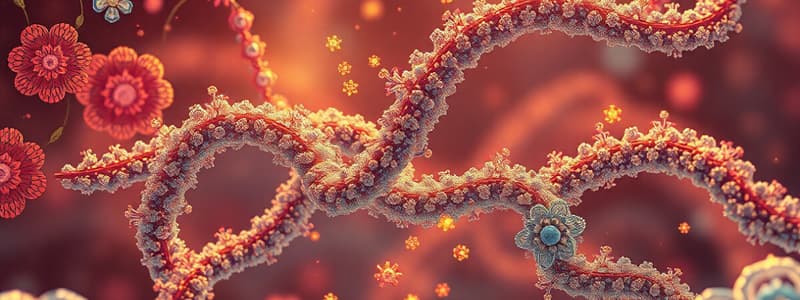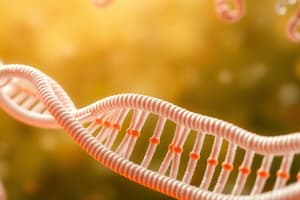Podcast
Questions and Answers
What is the process of converting genetic information into functional products called?
What is the process of converting genetic information into functional products called?
Gene expression
What is a heritable change in genetic material that can affect gene function?
What is a heritable change in genetic material that can affect gene function?
Mutation
What is an inherited metabolic defect caused by mutant genes?
What is an inherited metabolic defect caused by mutant genes?
Inborn error of metabolism
What is the metabolic disorder characterized by the accumulation of homogentisic acid?
What is the metabolic disorder characterized by the accumulation of homogentisic acid?
Who were the researchers who linked genes to enzyme synthesis?
Who were the researchers who linked genes to enzyme synthesis?
What hypothesis states that each gene controls the production of one enzyme?
What hypothesis states that each gene controls the production of one enzyme?
What describes the flow of genetic information from DNA to RNA to protein?
What describes the flow of genetic information from DNA to RNA to protein?
What is the process of synthesizing RNA from a DNA template?
What is the process of synthesizing RNA from a DNA template?
What type of RNA carries the genetic code for amino acid sequences?
What type of RNA carries the genetic code for amino acid sequences?
What type of RNA carries amino acids to ribosomes for protein synthesis?
What type of RNA carries amino acids to ribosomes for protein synthesis?
What type of RNA forms part of ribosomes?
What type of RNA forms part of ribosomes?
What is the enzyme that synthesizes RNA from a DNA template?
What is the enzyme that synthesizes RNA from a DNA template?
What is the modified guanine nucleotide added to the 5' end of mRNA?
What is the modified guanine nucleotide added to the 5' end of mRNA?
What is the string of adenines added to the 3' end of mRNA?
What is the string of adenines added to the 3' end of mRNA?
What is the process of removing introns and joining exons in mRNA?
What is the process of removing introns and joining exons in mRNA?
What is a three-nucleotide sequence in mRNA that specifies an amino acid?
What is a three-nucleotide sequence in mRNA that specifies an amino acid?
What refers to the fact that multiple codons can specify the same amino acid?
What refers to the fact that multiple codons can specify the same amino acid?
What are the enzymes that attach amino acids to their corresponding tRNA?
What are the enzymes that attach amino acids to their corresponding tRNA?
What is the molecular machine where protein synthesis occurs?
What is the molecular machine where protein synthesis occurs?
What is defined by the start codon and determines how codons are grouped?
What is defined by the start codon and determines how codons are grouped?
What is the formation of a peptide bond between amino acids?
What is the formation of a peptide bond between amino acids?
What are proteins that terminate translation at stop codons?
What are proteins that terminate translation at stop codons?
What stage in translation involves the lengthening of the polypeptide chain??
What stage in translation involves the lengthening of the polypeptide chain??
What is the end of translation upon reaching a stop codon?
What is the end of translation upon reaching a stop codon?
Transcription factors are only required in prokaryotes.
Transcription factors are only required in prokaryotes.
What is the DNA strand used for RNA synthesis during transcription?
What is the DNA strand used for RNA synthesis during transcription?
What DNA strand has the same sequence as mRNA (with T instead of U)?
What DNA strand has the same sequence as mRNA (with T instead of U)?
What process enables a single gene to produce multiple mRNAs?
What process enables a single gene to produce multiple mRNAs?
What are small nuclear ribonucleoproteins involved in splicing?
What are small nuclear ribonucleoproteins involved in splicing?
Flashcards
Gene Expression
Gene Expression
The process of converting genetic information from DNA into functional products, primarily proteins.
Mutation
Mutation
A permanent alteration in the DNA sequence of a gene, which can affect its function.
Inborn Error of Metabolism
Inborn Error of Metabolism
A genetic disorder caused by a defective enzyme due to a mutation in the gene responsible for its production.
Alkaptonuria
Alkaptonuria
Signup and view all the flashcards
Beadle and Tatum
Beadle and Tatum
Signup and view all the flashcards
One Gene-One Enzyme Hypothesis
One Gene-One Enzyme Hypothesis
Signup and view all the flashcards
Central Dogma
Central Dogma
Signup and view all the flashcards
Transcription
Transcription
Signup and view all the flashcards
mRNA
mRNA
Signup and view all the flashcards
tRNA
tRNA
Signup and view all the flashcards
rRNA
rRNA
Signup and view all the flashcards
RNA Polymerase
RNA Polymerase
Signup and view all the flashcards
5' Cap
5' Cap
Signup and view all the flashcards
Poly A Tail
Poly A Tail
Signup and view all the flashcards
Splicing
Splicing
Signup and view all the flashcards
Codon
Codon
Signup and view all the flashcards
Degenerate Code
Degenerate Code
Signup and view all the flashcards
Aminoacyl-tRNA Synthetases
Aminoacyl-tRNA Synthetases
Signup and view all the flashcards
Ribosome
Ribosome
Signup and view all the flashcards
Reading Frame
Reading Frame
Signup and view all the flashcards
Peptidyl Transfer Reaction
Peptidyl Transfer Reaction
Signup and view all the flashcards
Release Factors
Release Factors
Signup and view all the flashcards
Elongation
Elongation
Signup and view all the flashcards
Termination
Termination
Signup and view all the flashcards
Transcription Factors
Transcription Factors
Signup and view all the flashcards
Template Strand
Template Strand
Signup and view all the flashcards
Coding Strand
Coding Strand
Signup and view all the flashcards
Alternative Splicing
Alternative Splicing
Signup and view all the flashcards
snRNPs
snRNPs
Signup and view all the flashcards
Study Notes
Gene Expression Overview
- Gene expression is the process of converting genetic information into functional products.
- Mutations are heritable changes in genetic material that affect gene function.
- Inborn errors of metabolism are inherited defects resulting from mutant genes disrupting metabolic processes.
- Alkaptonuria is a metabolic disorder characterized by homogentisic acid accumulation.
- Beadle and Tatum linked genes to enzyme synthesis.
- The one gene-one enzyme hypothesis proposes that each gene controls the production of a single enzyme.
- The central dogma describes the flow of genetic information: DNA to RNA to protein.
Transcription
- Transcription is the synthesis of RNA from a DNA template.
- mRNA (messenger RNA) carries the genetic code for protein synthesis.
- tRNA (transfer RNA) carries amino acids to ribosomes.
- rRNA (ribosomal RNA) forms part of ribosomes, the protein synthesis machinery.
- RNA polymerase is the enzyme that synthesizes RNA using a DNA template.
mRNA Processing
- mRNA precursors undergo modifications like the addition of a 5' cap and a poly A tail.
- mRNA splicing removes introns (non-coding regions) and joins exons (coding regions).
Translation
- Codons are three-nucleotide sequences on mRNA that specify amino acids.
- The genetic code is degenerate, with multiple codons often specifying the same amino acid.
- Aminoacyl-tRNA synthetases attach amino acids to their corresponding tRNA molecules.
- Ribosomes are the sites of protein synthesis.
- The reading frame is determined by the start codon and dictates the grouping of codons.
- Peptidyl transfer reaction creates peptide bonds between amino acids.
- Release factors terminate translation at stop codons.
- Elongation is the stage where the polypeptide chain grows.
- Termination marks the end of protein synthesis.
Regulation of Gene Expression
- Transcription factors are proteins involved in initiating transcription in eukaryotes.
- The template strand of DNA serves as the template for RNA synthesis.
- The coding strand of DNA has the same sequence as the mRNA, differing only in the substitution of uracil (U) for thymine (T).
- Alternative splicing allows a single gene to produce multiple proteins by different mRNA arrangements.
- snRNPs (small nuclear ribonucleoproteins) play a role in mRNA splicing.
Studying That Suits You
Use AI to generate personalized quizzes and flashcards to suit your learning preferences.
Description
Explore the fundamentals of gene expression and transcription in this quiz. Learn about the processes that convert genetic information into functional products, including the role of various types of RNA and the one gene-one enzyme hypothesis. Test your knowledge on key concepts such as mutations and inborn errors of metabolism.




